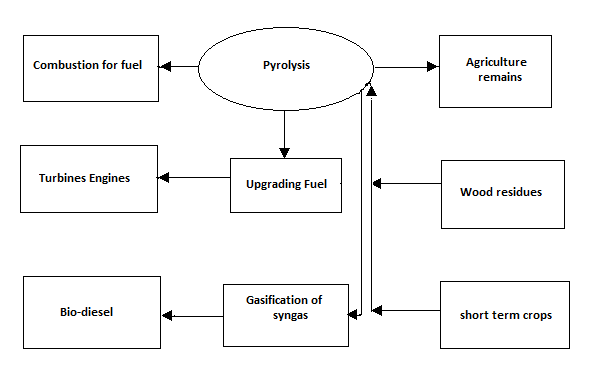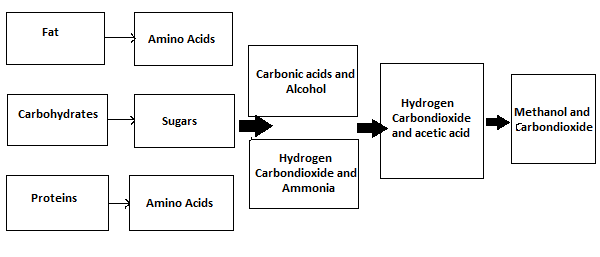
- Solar Energy - Introduction
- Solar Energy - Photovoltaic Effect
- Developing Solar Panel
- Solar Energy - Cell Efficiency
- Types of Photovoltaics
- Geothermal Energy
- Geothermal Energy - Introduction
- Geothermal Energy - Extraction
- Geothermal Energy - Geophysics
- Hydroelectric Power
- Hydroelectric Power - Introduction
- Hydroelectric Power - Turbine Types
- Hydroelectric Power Systems
- Hydraulic Ram Pump
- Renewable Energy Resources
- Renewable Energy - Quick Guide
- Renewable Energy - Resources
- Renewable Energy - Discussion
Bio Energy - Biomass Production
The organic material is converted into usable form known as bio-energy. The materials used in the process of energy production are termed as feedstock.
To better understand biomass, we will explore the various sources first.
Biomass production refers to the increase in the amount of organic matter. It is the addition of organic matter in a given area or population. Biomass is considered renewable energy because it is replenished as plants and animals grow.
There are two forms of production −
Primary production refers to the generation of energy by plants through photosynthesis. The excess energy generated is stored and adds up to the total biomass in the ecosystem. Primary production could be estimated from the total forest cover in a given year.
Secondary production is the absorption of organic matter as body tissues by organisms. It includes ingestion by animals i.e. feeding, whether on other animals or on plants. It also involves decomposition of organic matter by microorganisms. Secondary production could be estimated as the total meat produced per year.
Though biomass could be measured as mass of organisms living and dead in a given environment, production is harder to estimate. It can only be estimated as the increase in volume though part of the additional biomass may have been replaced through natural processes.
Direct Combustion for Heat
Direct combustion for heat is the oldest method of biomass conversion to energy since the earliest civilizations. Thermochemical conversion (combustion) could be achieved in a number of ways using varied feedstock.
Standalone Combustion
Biomass based generators use diesel derived from vegetable oils to fuel diesel generators. The generators burn the organic diesel to produce energy to produce electricity.
Combined heat and power plants are known to cogenerate electricity and useful heat energy. Ceramic industries utilize the heat in drying products such as clay tiles.
Some power plants use biomass to heat water and produce steam for electricity generation. The biomass is burnt to produce enough heat to boil water.
Municipal solid waste plants burn solid wastes to generate electricity. This type is prone to criticism since solid wastes mostly contain toxic gases from plastics and synthetic fibers.
Biomass Co-combustion
Apart from stand-alone combustion, biomass could be blended with other fossil fuels and burnt to generate energy. This is called co-firing.
Biomass could be directly burnt as coal. This is referred to as direct co-combustion.
In other cases, the biomass is first processed to gas and then converted to syngas.
The third case is where fossil fuel is burnt in a different furnace and the energy produced is then used to preheat water in a steam power plant.
Types of Combustion
The various types of combustion are −
Fixed bed combustion − This is a method where solid biomass is first cut into small pieces and then burnt on a flat fixed surface.
Moving bed combustion − In this method, a grate is set to constantly and evenly move leaving ash behind. The fuel burns in combustion levels.
Fluid-bed combustion − Fuel is boiled under high pressure mixed with sand. The sand serves to distribute the heat evenly.
Burner combustion − In this method, wood dust and fine dust are placed in a burner similar to that of liquid fuel.
Rotary furnace combustion − A kiln furnace is used to burn organic matter with high moisture content. Such waste as food residue or other moist farm waste is burnt this way.
Pyrolysis
Pyrolysis is another form of processing bio-fuels by burning under very high temperatures without oxygen, which could cause complete combustion. This causes irreversible physical and chemical changes. The absence of oxidation or halogenations processes results in a very dense bio-fuel that could be used in combustion, co-combustion or converted to gas.
Slow pyrolysis occurs at about 400oC. It is the process of making solid charcoal.
Fast pyrolysis occurs between 450oC to 600oC and results in organic gas, pyrolysis vapor, and charcoal. The vapor is processed by condensation to liquid form as biooil. This must be done within 1 second to prevent further reaction. The resultant liquid is dark brown liquid denser than wood biomass and has equal content in terms of energy.
Bio-oil has a number of advantages. It is easier to transport, burn, and store. Many kinds of feedstock can be processed through pyrolysis to produce bio-oil.
The diagram given below explains the process in converting energy in to a usable form from bio-fuels through Pyrolysis.

Alcoholic Fermentation
Alcoholic fermentation is the process that converts sugars into cellulose. The process results in ethanol and carbon dioxide as the by-products. This process is considered anaerobic since it takes place in the absence of oxygen. Apart from bread baking and manufacturing alcoholic beverages, this process produces alcoholic fuel. The chemical formula for alcoholic fermentation is given by −
$C_{6}H_{12}O_{6}+yeast\longrightarrow\:2C_{2}H_{5}OH+2CO_{2}$
Sugarcane is the main feedstock for this process especially in dry environments. Corn or sugar bits are used in temperate areas.
Application of Products
The products have the following applications −
Acetone is a product used for production of food additives, dissolving glue, thinning of paint, grease removers and in cosmetic products.
Hydrogen is used as a cooling agent in power industry. It is also used in hydrogen cells for energy production.
Butanol provides better fuel than ethanol. It is also used as an ingredient in paint, cosmetic products, resins, dyes, polymer extractions and in the manufacture of synthetic fiber.
Ethanol is used as fuel, paint component, and an additive in antiseptics. It is also used in alcoholic beverages.
Anaerobic Digestion of Biogas
Anaerobic digestion is the biological process by which organic matter is broken down to produce biogas in the absence of Oxygen. Microorganisms such as Acidogenetic bacteria and acetogens convert the biodegradable matter to biogas. Apart from being a source of energy, it is also a waste deposition method and environmental conservation technique.
The main equation for this conversion that yields carbon dioxide and methane is as follows −
$C_{6}H_{12}O_{6}\longrightarrow\:3CO_{2}+3CH_{4}$
The step-by-step process is explained below −
Step 1 − Breakdown of organic matter to sizable molecules for conversion. This process is known as hydrolysis.
Step 2 − Acidogens act on the decomposed matter converting them into volatile fatty acids (VFAs) alongside ammonia, CO2 and hydrogen sulfide. The process is called acidogenesis.
Step 3 − The VFAs are further broken down into acetic acid, carbon dioxide and hydrogen.
Step 4 − The final stage is the combination of emissions above to produce methanol, carbon dioxide, and water.
